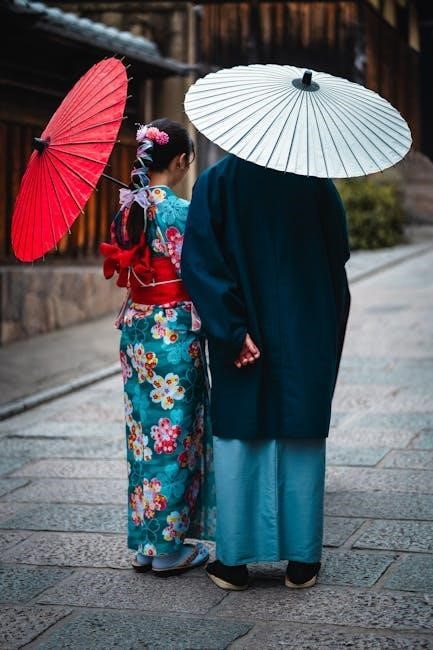Explore the captivating world of 1930s Japan through the eyes of Sayuri, a young geisha, in Arthur Golden’s timeless novel. This PDF memoir delves into her journey, blending cultural richness with emotional depth, offering a profound glimpse into a vanished world.

Overview of the Novel

Memoirs of a Geisha is a captivating novel by Arthur Golden, set in 1930s Japan. It narrates the life of Chiyo Sakamoto, a young girl sold to a geisha house in Gion, Kyoto. The story follows her transformation into Sayuri, a renowned geisha, detailing her struggles, triumphs, and the intricate world of geisha culture. With vivid descriptions and emotional depth, the novel explores themes of identity, resilience, and love, offering a unique glimpse into a vanished era. Golden’s masterful storytelling weaves historical context with personal drama, making it a timeless tale of survival and self-discovery. The PDF format allows readers to immerse themselves in this poignant journey seamlessly.
The Author: Arthur Golden
Arthur Golden, born in 1956 in Chattanooga, Tennessee, is an American author best known for “Memoirs of a Geisha.” Golden earned degrees in art history and Japanese, which deeply influenced his writing. His fascination with Japanese culture led him to research geisha traditions extensively. After interviewing a former geisha, he crafted a compelling narrative that blends historical accuracy with emotional depth. Published in 1997, “Memoirs of a Geisha” became an international bestseller, earning critical acclaim and solidifying Golden’s reputation as a masterful storyteller. His meticulous research and vivid storytelling have made the novel a timeless classic, offering readers a unique glimpse into a vanished world.
Historical Context
Set in 1930s Japan, Memoirs of a Geisha unfolds against the backdrop of a rapidly changing society. The novel captures the decline of the traditional geisha culture, threatened by modernization and Western influence. The onset of World War II further disrupts the lives of geisha, forcing them to adapt to unprecedented challenges. Golden weaves historical events, such as the war’s impact on Kyoto and the eventual occupation by Allied forces, into the narrative. The story also explores the societal shift from traditional values to more Westernized norms, highlighting the struggles of women in a patriarchal system. This historical context enriches the novel, offering a vivid portrayal of a vanishing world and its resilience in the face of change.

Plot Summary
The novel traces Chiyo Sakamoto’s journey from poverty to becoming the geisha Sayuri, navigating love, loss, and resilience in 1930s Japan, revealing her extraordinary destiny.
The Early Life of Chiyo Sakamoto
Chiyo Sakamoto, a young girl from a poor fishing village, is sold to a Kyoto hanamachi (geisha district) after her mother’s death. Her father, overwhelmed by grief and poverty, makes the difficult decision to sell Chiyo and her older sister, Satsu, to different houses. Chiyo’s life dramatically changes as she arrives in Gion, where she is taken in by the Nitta okiya, a geisha house. Despite her beauty and potential, Chiyo faces harsh treatment from the okiya’s cruel mother and the jealousy of the reigning geisha, Hatsumomo. Her early years are marked by loneliness, hardship, and the discovery of her unique features, particularly her striking blue-gray eyes, which set her apart. This period lays the foundation for her resilience and determination to rise above her circumstances.
The Journey to Becoming Sayuri
Chiyo Sakamoto’s transformation into Sayuri, a renowned geisha, is a tale of resilience and dedication. After being sold to a Kyoto geisha house, she endures harsh training and rivalries, particularly with Hatsumomo. Under Mameha’s guidance, Chiyo learns the arts of geisha, embracing the cultural and emotional demands. Her journey is marked by struggles, sacrifices, and the discovery of her own strength. The name Sayuri symbolizes her rebirth, as she rises from adversity to become a symbol of elegance and grace in Gion. This transition highlights the complexities of geisha culture and the profound personal growth required to excel in such a rigid world.
Key Events and Turning Points
The novel unfolds through pivotal moments that shape Sayuri’s life. Chiyo’s arrival in Gion and her initial struggles under Hatsumomo mark the beginning of her transformation. Meeting the Chairman for the first time sparks a lifelong connection, while her debut as a geisha, Sayuri, signifies her acceptance into this exclusive world. Mameha’s guidance proves crucial, as does the auction of her virginity, which becomes a defining yet traumatic experience. The rivalry with Hatsumomo escalates tension, culminating in a dramatic confrontation. Ultimately, Sayuri’s resilience and the Chairman’s enduring affection lead to a poignant resolution, highlighting her journey from hardship to hope and self-discovery.
Major Characters
Meet Chiyo, a young girl destined to become Sayuri, alongside Hatsumomo, her cruel mentor, Mameha, her guide, and the Chairman, whose presence shapes her fate profoundly.
Chiyo Sakamoto (Sayuri)
Chiyo Sakamoto, later known as Sayuri, is the protagonist of Memoirs of a Geisha. Born into poverty, Chiyo is sold to a geisha house in Gion, Kyoto, after her family’s tragic demise. Her journey from a young, naive girl to a renowned geisha is marked by resilience and determination. Chiyo’s striking beauty and inner strength set her apart, but her path is fraught with challenges, including the cruelty of her mentor Hatsumomo and the complexities of geisha politics. Her name is later changed to Sayuri, symbolizing her transformation. Throughout the novel, Sayuri’s story explores themes of identity, survival, and the enduring power of hope.
Her tale captivates readers, offering a deeper understanding of her world and spirit.
Hatsumomo
Hatsumomo, Chiyo’s older sister, is a complex and tragic figure in Memoirs of a Geisha. Sold alongside Chiyo to the Nitta okiya, Hatsumomo initially shows promise as a geiko. However, her career falters due to her inability to secure a danna, leading to a downward spiral of mental instability and alcoholism. Her relationship with Chiyo is strained, marked by jealousy and resentment. Hatsumomo’s story serves as a poignant reminder of the harsh realities faced by women in this rigid societal structure. Her eventual disappearance leaves a lasting impact on Chiyo, highlighting the fragility of hope and the devastating consequences of failure in their world. Hatsumomo’s character underscores the novel’s themes of resilience and the unyielding societal expectations placed on geisha.
Mameha
Mameha, a renowned geisha and mentor to Chiyo, plays a pivotal role in shaping Sayuri’s career. Known for her wisdom, elegance, and strategic thinking, Mameha guides Sayuri through the intricate world of Gion. Her patience and dedication help Sayuri overcome challenges, while her own backstory reveals the sacrifices geisha often make. Mameha’s influence extends beyond training; she becomes a source of strength and inspiration for Sayuri, teaching her the art of resilience and the importance of grace under pressure. Through her character, Golden highlights the complexities of mentorship and the enduring bonds formed in the geisha community.
The Chairman
The Chairman, a wealthy and influential figure, plays a pivotal role in Sayuri’s life. His calm demeanor and air of authority captivate her, symbolizing a longing she cannot express. A member of the elite, he represents both power and kindness, offering Sayuri moments of solace amidst her struggles. His subtle interactions with her reveal a deep, unspoken connection, contrasting sharply with the harsh realities of her world. The Chairman embodies the refined elegance of Japan’s traditional culture while also highlighting the complexities of desire and unattainable love. His presence underscores the novel’s themes of resilience and the enduring power of silent emotions.

Themes in “Memoirs of a Geisha”
The novel explores themes of identity, resilience, and love, delving into the complexities of human emotion and cultural heritage, all set against Japan’s fascinating backdrop.
Identity and Self-Discovery
Chiyo Sakamoto’s transformation into Sayuri embodies the struggle for identity and self-discovery. Born into poverty, she navigates a world where her name, status, and purpose are redefined. The geisha culture forces her to adopt a new identity, separating her true self from her public persona. Through trials and mentorship, Sayuri learns to embrace her dual existence, finding strength in her resilience. Her journey reflects the universal quest to reconcile inner truth with societal expectations, ultimately revealing the enduring power of self-discovery in shaping one’s destiny.
Resilience and Survival
In Memoirs of a Geisha, resilience and survival are central themes, as Chiyo navigates a world of hardship and transformation. From her impoverished childhood to the cruel realities of geisha training, Chiyo’s determination to endure shines through. Her ability to adapt and thrive in a rigid, unforgiving system underscores the strength of her spirit. The novel highlights how survival often requires sacrifice, as Chiyo faces heartbreak, betrayal, and societal constraints. Yet, her resilience is not passive; it is a deliberate choice to rise above adversity. This theme resonates deeply, showing how individuals can find strength in the face of oppression and adversity, making Memoirs of a Geisha a powerful exploration of the human spirit.
Love and Longing
At the heart of Memoirs of a Geisha lies a profound exploration of love and longing. Sayuri’s unrequited love for the Chairman drives her journey, while her complex bond with Hatsumomo reflects twisted affection. The novel portrays love as both a source of hope and a burden, shaped by societal expectations. Sayuri’s longing for connection transcends romantic love, encompassing her desire for acceptance and belonging. Golden masterfully weaves these emotions into the fabric of the story, creating a universal resonance. Through Sayuri’s struggles and sacrifices, the novel underscores the enduring power of love, even in the face of adversity and cultural constraints.

Cultural Significance
Memoirs of a Geisha offers a unique lens into Japan’s geisha culture, blending tradition, beauty, and resilience, while sparking global conversations about cultural accuracy and representation.
The Geisha Culture
In Memoirs of a Geisha, the geisha culture is portrayed as a centuries-old tradition where women are trained as skilled entertainers, excelling in music, dance, and poetry. Geishas, or “artists of pleasure,” are not merely performers but embodiments of elegance and refinement, chosen for their beauty and grace. Their role in society is unique, straddling the line between artistry and companionship. The novel highlights the rigorous training and sacrifices required to become a geisha, as well as the intricate hierarchy within the geisha community. While the book sparks admiration for this enigmatic world, it also fuels debates about the accuracy of its portrayal and the ethical complexities of this storied tradition.
The Setting: Gion and Kyoto
Gion, Kyoto’s famed geisha district, serves as the vivid backdrop of Memoirs of a Geisha. The novel meticulously captures the district’s narrow cobblestone streets, traditional tea houses, and the serene beauty of its temples and gardens. Kyoto itself, with its rich cultural heritage, provides a stunning contrast between ancient traditions and the encroaching modernity of 1930s Japan. The setting is not merely a location but a character in its own right, shaping the lives of the geisha and influencing their stories. The PDF version of the memoir allows readers to visualize Gion’s charm through descriptive language, immersing them in a world steeped in history and elegance.
Cultural Accuracy and Controversies
Arthur Golden’s portrayal of geisha culture sparked both acclaim and criticism. While praised for its detailed depiction of rituals, traditions, and the intricate world of geishas, some argued the novel romanticized their experiences. Critics, including former geishas, pointed out inaccuracies and the perpetuation of stereotypes, such as the portrayal of geishas as victims rather than independent artists. The novel’s reliance on interviews with former geisha Mineko Iwasaki added authenticity but also drew controversy, as Iwasaki later disputed certain representations. Despite these debates, the book remains a significant cultural touchstone, fostering global interest in geisha history while highlighting the complexities of cultural interpretation and representation.
Symbolism and Motifs
Arthur Golden masterfully weaves rich motifs and symbols throughout the novel, each carrying profound significance and enriching the storytelling and thematic exploration of Sayuri’s journey.
The Cherry Blossom
The cherry blossom is a poignant symbol in Memoirs of a Geisha, representing the fleeting beauty and fragility of life. Its brief bloom mirrors Chiyo’s journey, where moments of joy are tempered by impermanence. The blossom also embodies the delicate balance between beauty and hardship, a recurring theme in Sayuri’s story. In Japanese culture, cherry blossoms signify the transience of existence, and Golden uses them to underscore the ephemeral nature of a geisha’s life. Their presence in key moments highlights the tension between beauty and sorrow, making the cherry blossom a powerful and evocative motif in the novel.
The Kimono
The kimono in Memoirs of a Geisha is a profound symbol of Japanese culture and identity. It represents tradition, artistry, and the intricate social hierarchy of the geisha world. Chiyo’s transformation into Sayuri is marked by her elaborate kimonos, which signify her status and beauty. Each garment is meticulously designed, reflecting seasons, occasions, and the wearer’s emotional state. The kimono also serves as a tool for expression and concealment, as geishas use them to mask their true selves. However, the heavy, ornate fabrics often feel suffocating to Chiyo, symbolizing the constraints of her world. The kimono thus embodies both the elegance and the oppression central to geisha culture, making it a powerful motif in the novel.
The River
The river in Memoirs of a Geisha is a poignant symbol of Chiyo’s journey and emotional depth. It represents her separation from her family and the flow of her life’s trajectory. Early in the novel, the river serves as a pathway to her new identity, marking the end of her childhood. Later, it becomes a reminder of her past, evoking memories of her sister and the life she lost. The river’s constant flow mirrors the relentless passage of time and the inevitability of change. This motif underscores themes of loss, longing, and the search for belonging, making it a powerful and recurring element in Sayuri’s story.

Reception and Legacy

Memoirs of a Geisha became a bestselling phenomenon, earning widespread acclaim and numerous awards. Its lasting impact has solidified its place as a modern classic, enriching global cultural discussions and libraries worldwide.
Critical Reviews
Arthur Golden’s Memoirs of a Geisha received widespread critical acclaim for its vivid storytelling and emotional depth. Reviewers praised the novel’s ability to transport readers to 1930s Japan, immersing them in the intricate world of geisha culture. The character of Sayuri was particularly celebrated for her resilience and complexity. However, some critics argued that the novel romanticized certain aspects of geisha life and lacked cultural authenticity. Despite these debates, the book remains a literary triumph, offering a compelling narrative that blends tradition with modern sensibilities. Its success has endured, making it a staple in contemporary literature and a favorite among readers worldwide.
Commercial Success
“Memoirs of a Geisha” became a global phenomenon, topping bestseller lists worldwide. Over 4 million copies were sold in the U.S. alone, with millions more internationally. Its PDF version remains highly sought after, offering readers unparalleled accessibility to the story. The novel’s success led to translations in over 30 languages, further expanding its reach. Its enduring popularity has solidified its place as a modern classic, with the digital format ensuring its timeless tale continues to captivate new generations of readers. The book’s commercial success also paved the way for its adaptation into a film, further cementing its cultural impact. The PDF memoirs of a geisha remain a testament to its universal appeal and lasting influence.
Cultural Impact
The novel has significantly influenced global perceptions of Japanese culture, particularly the mysterious world of geisha. While it sparked widespread interest and admiration, it also faced criticism for cultural inaccuracies and romanticization. The book’s success paved the way for increased Western curiosity about Japanese traditions, inspiring countless discussions and debates. Despite controversies, its impact on popular culture remains undeniable, with themes and imagery from the novel appearing in films, art, and literature. The PDF version of Memoirs of a Geisha continues to be a vital resource for exploring these cultural dynamics, offering readers a window into a fascinating yet complex world.
Adaptations and Interpretations
The novel has inspired various adaptations, including a 2005 film directed by Rob Marshall and stage productions that bring Sayuri’s story to life in different artistic forms.
The Film Adaptation
In 2005, Memoirs of a Geisha was adapted into a film directed by Rob Marshall, featuring Zhang Ziyi as Sayuri. The movie captures the novel’s emotional depth and cultural richness, with stunning visuals and performances. Ken Watanabe and Michelle Yeoh also starred, adding depth to the narrative. The film explores themes of identity, resilience, and love, staying true to the novel’s essence while bringing its vivid world to life on screen. While it received mixed reviews from critics, it was a commercial success and introduced the story to a broader audience, highlighting the geisha culture’s beauty and complexity. The film remains a celebrated interpretation of Golden’s work.
Stage Productions
The novel has inspired various stage adaptations, including a notable musical production. These adaptations bring the story of Sayuri to life through captivating performances, intricate costumes, and emotional storytelling. The stage productions emphasize the cultural and emotional depth of the novel, allowing audiences to experience the geisha’s world in a new dimension. The musical adaptation, in particular, features stunning visuals and haunting melodies that resonate with the themes of love, loss, and resilience. These productions have been well-received globally, further cementing the novel’s legacy as a timeless tale of human endurance and the pursuit of one’s destiny.

Reading “Memoirs of a Geisha” in PDF Format
Experience the convenience of reading “Memoirs of a Geisha” in PDF format, offering portability and accessibility. Adjust font sizes, read in night mode, and carry the story effortlessly on any device.
Advantages of the Digital Version
Reading Memoirs of a Geisha in PDF format offers unparalleled convenience. The digital version allows for easy portability, enabling readers to carry the novel on smartphones, tablets, or laptops. Adjust font sizes for optimal readability and utilize features like night mode for comfortable reading in any setting. The PDF format also supports annotations and bookmarks, enhancing the reading experience. Additionally, digital storage saves physical space and reduces clutter. Access to the novel is instant upon download, and the ability to search for specific phrases or characters makes it ideal for research or revisiting favorite scenes. Overall, the digital version provides flexibility and accessibility, making it a modern and practical way to enjoy this beloved story.

Downloading and Reading Tips
Downloading Memoirs of a Geisha in PDF format offers convenience and accessibility. Ensure you use trusted sources to avoid malware risks. Choose an eBookstore or reputable website for a secure download.
For optimal reading, adjust font sizes and brightness to suit your eyes. Use a dedicated PDF reader for a seamless experience. Consider using night mode to reduce eye strain in low-light settings.
Enhance your reading by enabling bookmarks and annotations. This allows you to highlight meaningful passages and track your progress. For mobile users, download the file over Wi-Fi to save data and ensure quick access.
Finally, find a quiet, comfortable space to immerse yourself in Sayuri’s story. A distraction-free environment will deepen your connection to the narrative and its emotional depth.
Enhancing the Reading Experience
Enhance your reading of Memoirs of a Geisha in PDF format by adjusting font size and brightness for optimal comfort. Use bookmarks to track pivotal moments, and highlight passages that resonate emotionally. Adding notes or annotations can deepen your understanding of cultural nuances. Consider pairing the text with historical images of 1930s Gion or traditional Japanese art to visualize the setting. For a richer experience, listen to traditional Japanese music while reading to immerse yourself in the era. Additionally, explore companion resources like character maps or historical timelines to further enrich your journey through Sayuri’s story.
“Memoirs of a Geisha” is a hauntingly beautiful tale of resilience, love, and identity, offering timeless insights into Japan’s geisha culture. The PDF format preserves its magic perfectly.
Final Thoughts on the Novel
“Memoirs of a Geisha” is a mesmerizing exploration of identity, resilience, and the intricate world of geisha culture. Through Sayuri’s journey, Arthur Golden masterfully weaves a tale of love, sacrifice, and self-discovery, set against the backdrop of Japan’s shifting cultural landscape. The novel’s vivid storytelling and richly drawn characters create a deeply emotional and immersive experience. Its themes of perseverance and the pursuit of one’s destiny resonate universally, making it a timeless classic. The PDF format allows readers to conveniently access this beautiful story, ensuring its enduring legacy. It is a must-read for anyone drawn to historical fiction, cultural depth, and the transformative power of the human spirit.
Recommendations for Further Reading
If you enjoyed Memoirs of a Geisha, explore these books for deeper insights into Japanese culture, geisha traditions, and compelling female narratives:
- A Geisha’s Journey: My Life as a Kyoto Apprentice by Naomi Kawashima—a memoir offering a modern perspective on geisha life.
- The Life of a Geisha by Sienna Browne—a historical exploration of the geisha world.
- The Pleasure of Japanese Literature by Donald Keene—a collection of essays on Japanese literary classics.
- The Makioka Sisters by Junichirō Tanizaki—a novel about tradition and identity in Japan.
These works provide a richer understanding of the cultural and historical context of Memoirs of a Geisha.





